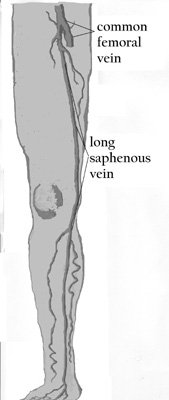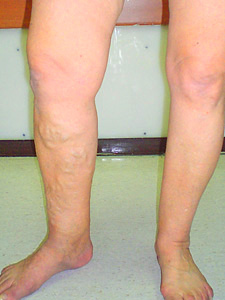It is commonly believed that vein disease treated by surgical means is bound to reappear within a period of several years following surgery. In actual fact this is not the case.
When venous surgery is not performed properly there is an increased chance for recurrence of the disease. However, when properly performed, vein surgery is extremely effective and more than 95% of patients undergoing vein surgery enjoy the results for many years after.
Vein surgery requires extended experience and competence on the part of the surgeon.
When surgery is performed by an expert in the field the percentage of complications is minimal and the patient is able to stand on his feet within hours from surgery.
There are several types of vein surgery:
- Surgery for treatment of incompetence of the central superficial venous system. The most common vein surgery is stripping – the removal of the great or small saphenous vein through cuts in the groin or along the leg. Such surgery is performed under local or general anesthesia. In cases of insufficiency of the great saphenous vein, surgery begins with an incision in the groin area, followed by a procedure for the removal of the entire length of the vein with the help of specialized tools. If necessary, varicosities are removed separately through small incisions to the length of the leg.
- Surgery in cases with no incompetence of the central superficial venous system. This type of surgery is performed under local, partial or general anesthesia, and varicosities are removed separately through small incisions to the length of the leg.
|
|
|
|
|
|
Rates of success and adverse effects
The success rates for this type of surgery are very high, nearing 97%, but as with any invasive procedure there is a possibility for rare complications and adverse effects. A surgical incision leaves a scar, and the nature of the scar depends on the skin’s ability to heal. Occasional, following surgery, bruising appears which is normally absorbed over a period of days. Rarely, infection, bleeding or nervous damage may be seen
Blood vessels are important organs in the human body.
The arteries transport oxygen and nutrients to the body’s organs and tissues.
The veins are responsible for removing waste from all tissues.
Vascular diseases cause damage to organs and tissues.
Narrowing or blockage to arteries causes poor oxygenation, and vein diseases cause swelling and poor circulation.
Arterial diseases usually appear at later ages, however vein diseases can also inflict young people.
Modern medications can help prevent narrowing of arteries to a certain extent, but unfortunately it is impossible to halt the progression of age.
When medication fails us – surgery comes to our aid. Vein surgery is a broad and complex field of medicine.
It is my hope that any person suffering from vascular problems and is interested in the various possible treatments will find the answers to many, if not all of his questions, in this site.
Dr. Ilya Krakovsky






